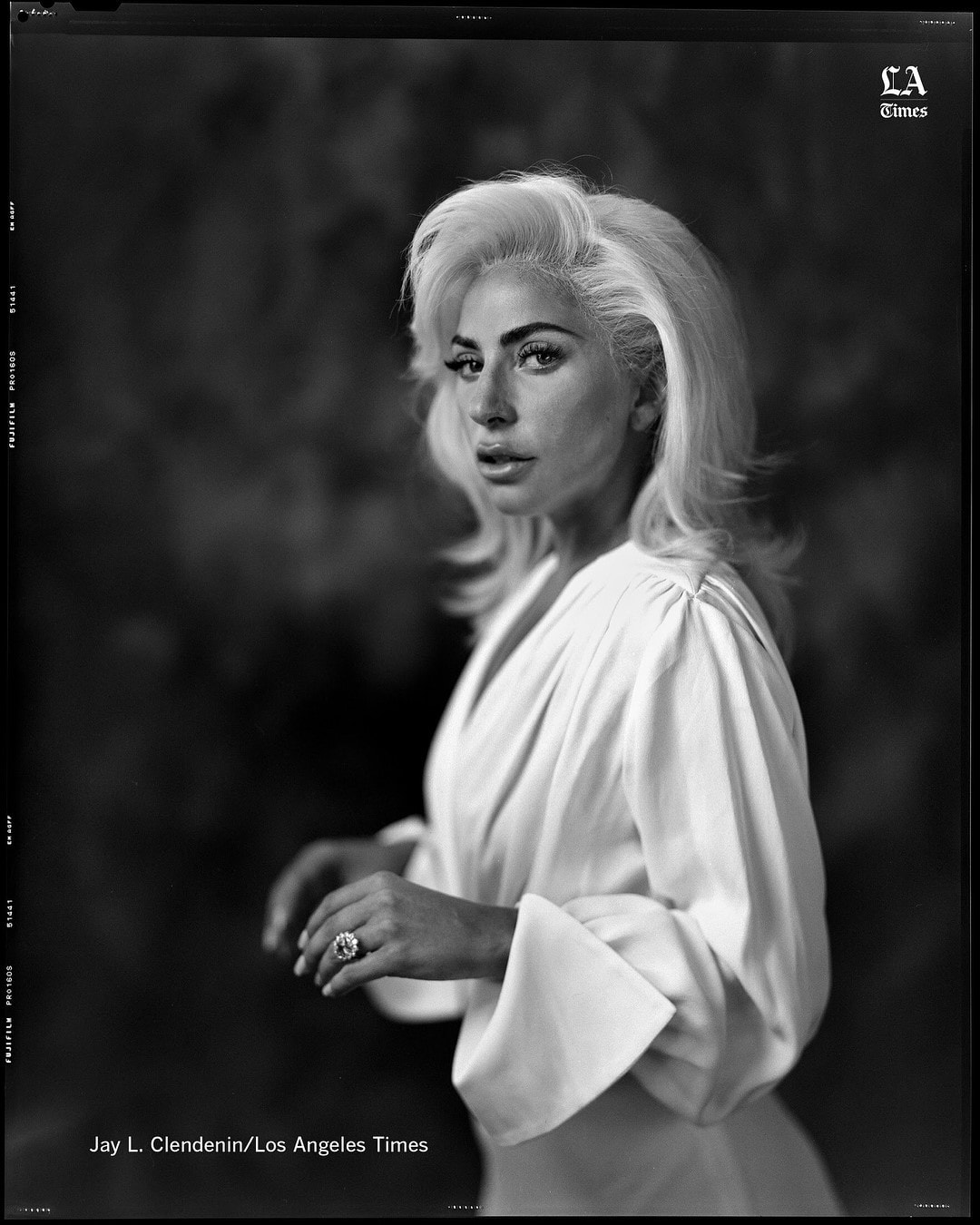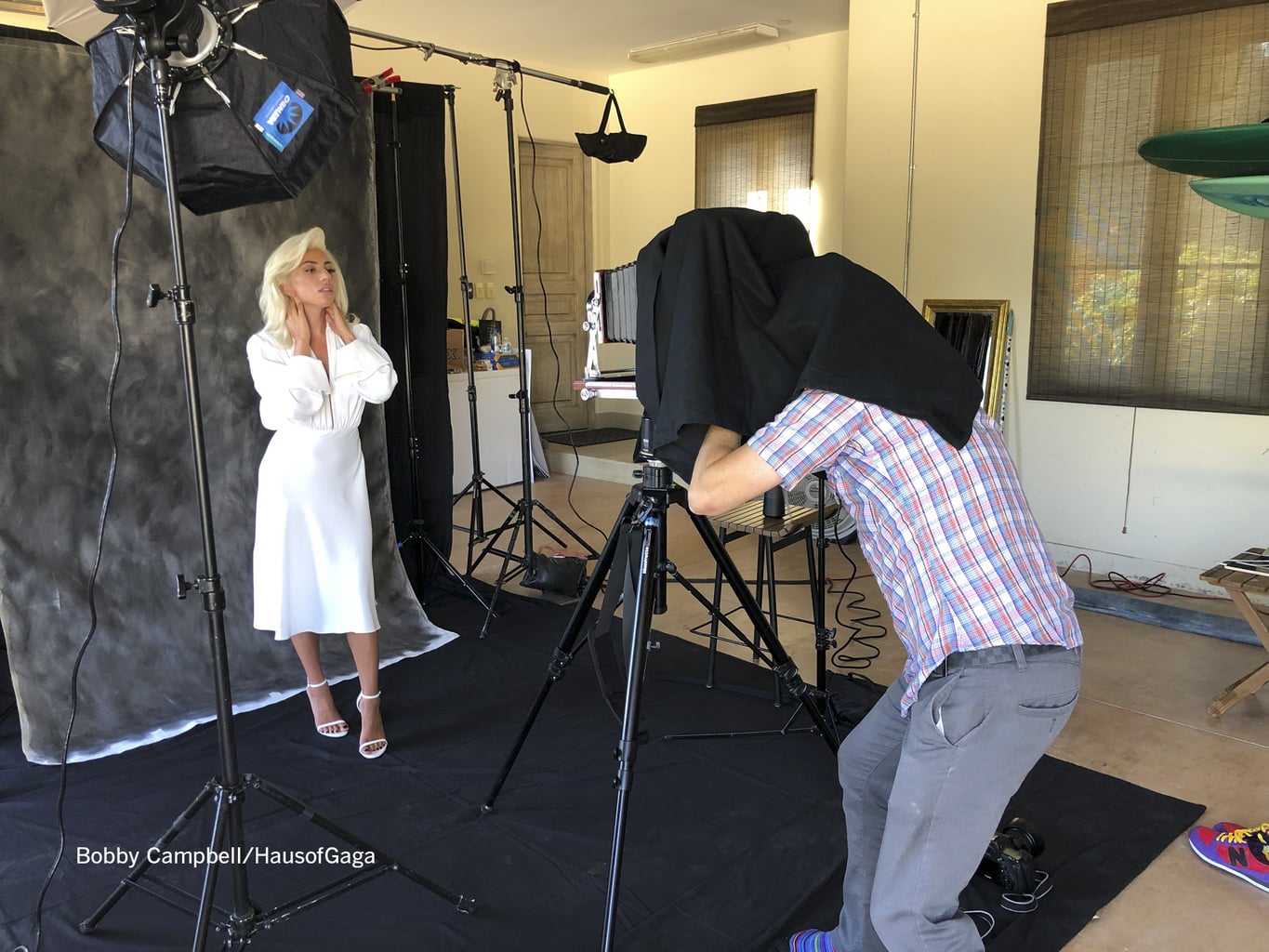Share
A Star is Born – Jay L. Clendenin Goes Large with Lady Gaga
This weekend, Lady Gaga makes her leading actress debut in the fourth remake of A Star is Born co-written, starring, and directed by Bradley Coope...
This weekend, Lady Gaga makes her leading actress debut in the fourth remake of A Star is Born co-written, starring, and directed by Bradley Cooper. The critics are predictably going, well, gaga over it.
PR, of course, plays a role in any film’s success, and as Hollywood’s paper of record, the Los Angeles Times has a hand in highlighting the comings and goings in tinseltown. For the past eleven years, Los Angeles Times staff photographer Jay L. Clendenin has earned a reputation as a celebrity portrait photographer, and has become a fixture on the film festival circuit.
As a part of the paper’s Fall Movie Preview, Clendenin knocked a name off his bucket list by being tapped to photograph Lady Gaga. But instead of solely relying on digital, Clendenin reached for his 8×10 camera.
Brilliant creative or glutton for punishment? I caught up with him on his way to the Toronto Film Festival.
This interview has been lightly edited for length and clarity.
***
For an assignment like this, do you get a specific brief from the DOP/editor, or is it pretty vague?
Like the majority of my portrait shoots, I am on my own to decide what I want to attempt. I immediately envisioned dragging out my big film camera as an opportunity to shoot such an icon calls for something unique. I actually don’t think much about how it will run, but I have enough of a track-record at this point that I was sure our designers would come up with a cool section cover.

Celebrities are notoriously fickle with their time. Why the heck did you think shooting 8×10 with Lady Gaga was a good idea, and did you pre-clear the idea with her publicist before the shoot?
Time is of the essence on these celebrity portraits. There is a misconception that because we’re the L.A. Times, we’ll have extra time and be able to do whatever we want. The truth is, while we are seen as very important in Hollywood, as a record of the industry and all that it does, we aren’t a glossy magazine that sits out for a week, or a month. Those outlets definitely hold more power when negotiating time and ideas.
In this case, Gaga’s team was seeing this as a great opportunity to have a big display in the Times and our film editor, in talking with the studio, made it clear we were hoping this could be our fall preview cover. We do not promise covers. We work at a daily newspaper, things change by the end of many days! But we will definitely hint; the better the photo, the higher chance of getting a cover. The day before the shoot, the studio set up a call with her manager. We had a 25 min conversation. We discussed my hopes and dreams and then I sent him my Instagram feed ( @jlcvisuals ) and my website, and directed him to my film work and how I saw this as a beautiful black and white image.

Arriving at a beautiful home in Malibu, I quickly made the garage my home, laying out four options of painted canvases (done by my wife @nancypastorphoto) and we discussed clothing options. Most of these shoots happen in hotel rooms during press junkets with very little information, like clothing options, being given to me in advance. Gaga and her team were very interested in this shoot, as it was her first major film role and first major L.A. Times cover, so working WITH me was part of this process.
I think she liked my idea of black and white and went with the white dress, against my dark background, with it in mind. When I bring out my big film cameras, I always make a point to set it up in plain view when they walk in the room. It’s a sight to behold, dark cloth and all. So when she walked in, she immediately commented on it and made a point to say she really liked the work I did with it. The key was making sure her manager had the website and I was quick to remind him again before our shoot time!

When I have a subject this iconic, I try to push for my film camera, because it helps slow down the process and many (most?) subjects see it for the art that it is. One shot. One frame. It makes our collaboration that much more important, because when I say, “OK FREEZE! Don’t move!” and come out from under the dark cloth, they’re invested in the frame, moving means out-of-focus, it means we have to do ANOTHER one!
What sort of preparation did you do beforehand?
Prep is key with these big shoot and it starts with making sure I can get everything in my car! Besides my normal bag of lights in the trunk, my backseat was full of stands and two background-stand kits, as well as a giant case for my 8×10 camera. I went in with two film holder loaded with black and white photo paper (paper negative), one holder with two sheets of color ISO 160 (only ended up shooting one) and one holder with two sheets of T-MAX 100 black and white film.
The film (ISO 160 and 100), I could easily shoot with my strobes, whereas the paper negatives, with an ISO ranging between 5-10 (read: super slow!), takes more power than my normal strobe kit. Plus I like the fall-off, shooting wide open (f/5.6) using natural light! So, exposures outside, in open shade, ranged from 1/4-1 sec, wide-open.
What type of gear did you use (camera, lens, lighting, tripod!, film) – and what sort of exposure did you need?
The majority of my camera gear is Canon digital, utilizing my 5DS R and 5D Mark IV, with 24-70 II f/2.8, an 85mm f/1.2 and 45mm f/2.8 tilt-shift lenses . My big camera is an 8×10 Tachihara wood view camera and an oversized Manfrotto 475b tripod with Arca Swiss head. I used three Profoto D2 heads for the lit images and available light for the outdoor images made on the paper negatives!

You used paper negative outside, which is very sensitive to blue wavelengths – is this the cause of the dark skin tones?
YES! Great point, which def became a question once I put the images in social media. Unfortunately, some people commented that Gaga was in “blackface” with the shift in skin tones, but yes, it’s the limitations of the photo paper. As Gaga was very tan, the warm tone of her skin produces a “darker” look. It’s most notable in the closer image, but less so in the double exposure, which is more overexposed. Some may consider it a downside of the “film” choice, but honestly, I like the imperfections in my use of various films (see my Polaroid type-55 and New55 portraits) and there is a budget concern. I’m not going to lie, shooting film is expensive and this size film can be prohibitively expensive! It runs about $20 a shot, not including the investment in camera and film holders and then it’s about $50 for a drum scan of an 8×10 sheet of film!
Unlike some portrait photographers who are known for a very specific style (e.g. Dan Winters, Martin Schoeller), you have a very wide palette of media (digital, film, instant, boomerang) and varied look-and-feel. Can you elucidate your approach?
I’ve been doing this for 20 years, working as a photographer. The majority of it as a photojournalist, working for editorial outlets, with various corporate and commercial gigs up until coming to the L.A. Times about 11 years ago. While I have always enjoyed a variety of gigs and obviously the pay of some over others, the love has been in editorial, where I’m getting to document history and meet people from all walks of life.
That variety and diversity of people and assignments is what keeps me interested in making pictures; variety. While i admire portrait photographers who have made careers with particular lighting or post-processing, I know I would get bored if I was asked to do the same thing/look in all my pictures. And that may be another reason, the fact that i shoot A LOT of portraits. I’m not doing portraits once or twice a week, I’m generally shooting assignments five days each week, with the majority being portraits. I SHOOT A LOT OF PORTRAITS! It’s actually very stressful. I have to come up with something different, very often! Lighting, lenses, backgrounds, inside, outside, all those variables, multiple times each week.
But, I love it. The challenge of figuring all those things out, for each subject and collaborating with them to make something cool! Another big point, maybe the biggest, is that at the L.A. Times, we don’t use photoshop to re-touch images or “overly” process images. This is a big contrast, compared to magazines, where fixing skin blemishes, adding background or digitally altering in any way, is often implemented, in particular with covers. I’m not saying this as a knock against magazines, in particular those running celebrity portraits, but more so to say I work under more constricting guidelines and have to rely on in-camera expertise. Shooting film, even with 20 years of experience, is an experiment in serendipity with every exposure, which for me, is part of the fun and excitement of loading my Hasselblad, Polaroid, 4×5 or 8×10 film holders! Do they always work? NO! I’ve had plenty of failures, but those years of experience have taught me to have some back-up options, knowing that my film is usually icing on the cake!
You’ve shot a lot of film festivals where actors are cycling through interview and photo shoot after one another. Do you have any secret tips so that they give you a little something extra?
I’ve now created L.A. Times photo and video studios at the Sundance and Toronto film festivals and San Diego Comic Con. These events yield a few hundred portraits by festival’s end, shooting an average of 11 films or shows each day, with cast photos and then individuals. It’s brutal. The one thing that I’ve been doing since the beginning and now seem to be remembered for it, is bringing prints of previous shoots with the subjects.
Not so much single portraits, but more of their previous cast shots and red carpet appearances I may have shot. For most, it’s the first time the’ve seen the pictures and in actual print form! The reactions are great, usually of surprise, but mostly of thanks, as I’m giving them some small piece of their history in this business, different form the thousands of pictures online, something in an envelope that they can send to Mom or show their kids, or, as someone said, for their “scrapbook.” This has helped me get an extra minute, or convinced people, after their publicist had said “no,” to give me a single, or get them to do a Polaroid when they had been telling all the studios, “no solos!”
Any celebrities you’re dying to shoot?
Well, Gaga was definitely on the dream-shoot list, such an icon of our times. Other people, a list, in no particular order: Sean Penn, Michael Fassbender, Daniel Craig, Tilda Swinton, Julia Roberts, Jennifer Lawrence and on the political end, taking me back to my DC politics days, Obama and Trump.


